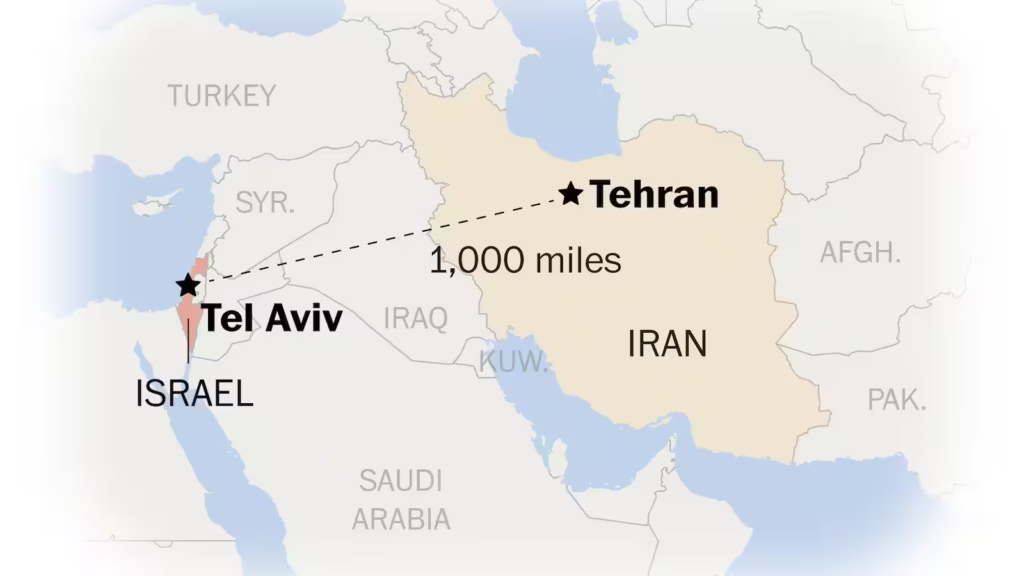By | InDepthReports

In the early hours of June 11, 2025, the skies above central Iran erupted in streaks of fire. Drones, missiles, and the ominous hum of high-altitude surveillance aircraft signaled a second wave of Israeli strikes against the Islamic Republic. Unlike previous isolated incidents, this new escalation appears to mark a dramatic evolution in the long-standing shadow war between Israel and Iran—a conflict now being waged across air, cyber, and human domains.
This investigative report examines the latest developments in the Israel-Iran conflict, based on intelligence briefings, satellite imagery, insider testimony, and expert analysis. What emerges is a chilling portrait of a war no longer confined to borders but embedded within technologies, alliances, and the very architecture of Middle Eastern geopolitics.
The New Strike Doctrine
On June 11, Israeli aircraft penetrated Iranian airspace and struck at least seven strategic locations, including a military radar base near Isfahan and suspected missile depots near Kermanshah. Satellite imagery reviewed by InDepthReports confirms extensive structural damage at two of the sites.
“These are not retaliatory strikes. They are part of a systemic degradation campaign,” said Col. Yaron Naveh (Ret.), a former Israeli Air Force planner now with the Institute for National Security Studies in Tel Aviv. “Israel is reshaping the battlefield by targeting Iran’s capacity to wage war tomorrow, not just today.”
Iran’s response was muted but not absent. Hours later, pro-Iranian militias in Syria and Iraq launched a salvo of rockets toward Israeli positions in the Golan Heights. Hezbollah claimed responsibility for a drone strike on an Israeli Defense Forces outpost in northern Israel the next morning, which left three soldiers injured.
Drones, Data, and Digital Warfare
The technological dimension of this conflict is growing more sophisticated. Israeli cyber units reportedly disrupted air defense communication grids in central Iran minutes before the June 11 strike. An Israeli official familiar with the operation said, on condition of anonymity, that Unit 8200 had been “laying the groundwork for weeks, mapping digital weak points in Iran’s defensive network.”
For its part, Iran has invested heavily in digital espionage and has intensified cyber operations against Israeli infrastructure. In late May, a group calling itself “Black Resistance” claimed responsibility for a cyberattack that disrupted train scheduling systems across southern Israel. While Israel has not officially confirmed the breach, cybersecurity firm CheckPoint attributed the intrusion to Iranian-backed operatives.
Dr. Laleh Khalili, a Middle East security expert at Queen Mary University of London, noted, “We’re witnessing a shift where cyberspace is no longer an auxiliary theatre. It is now a primary front line in this war.”
The Human Element
Behind the machines and code are real people—scientists, intelligence officers, and covert operatives. Iranian state media reported the assassination of Brig. Gen. Vahid Jalilian, a missile program director, in Shiraz on June 5. Jalilian was shot by unknown gunmen while leaving a government facility.
A Western intelligence source told InDepthReports, “This was a precision hit, likely by Mossad or an allied proxy. Jalilian had access to IRGC’s long-range missile plans.”
Meanwhile, Israel is on high alert for potential reprisals. Security has been heightened around Israeli embassies in Europe and South America. Mossad Director David Barnea reportedly warned German counterparts during a meeting in Berlin that Iran might use local proxies to conduct targeted killings abroad.
The Strategic Landscape
The regional map is shifting under the weight of this conflict. Jordan has quietly allowed Israeli drones to pass through its airspace. Saudi Arabia, while officially silent, has reportedly increased intelligence sharing with both Israel and the United States since April.
Dr. Christina Steenkamp of Oxford Brookes University told InDepthReports, “What we’re seeing is not just bilateral tension, but a restructuring of alliances. The lines between cooperation and complicity are blurring.”
On the other side, Iran is reinforcing ties with Russia and North Korea. Satellite images show increased activity at Parchin military complex, where analysts suspect North Korean advisors are involved in missile testing.
The Domestic Fronts
Inside both countries, the war is leaving visible marks. In Iran, public anxiety is growing amid economic hardships and the visibility of foreign drones in the skies. Anti-aircraft fire is now a weekly occurrence in Tehran’s suburbs.
In Israel, the security establishment is enjoying unprecedented public support. However, critics warn of overreach. Human rights groups have documented increased surveillance of Arab-Israeli communities under the justification of countering Iranian proxies.
Miri Eisin, a former Israeli military intelligence officer, cautioned, “Success on the battlefield can mask deeper vulnerabilities—especially when a state begins to compromise its own democratic norms.”
An Unfinished War
As the Israel-Iran conflict intensifies, it is no longer a war of deterrence it is a war of tempo, timing, and technological superiority. What was once a cold war of deniable strikes is becoming a hot, hybrid confrontation with global implications.
The question is no longer if the conflict will escalate, but how far it will go before the region and the world—are forced to reckon with its consequences.